
The Lewis and Clark class of dry cargo ship is a class of 14 underway replenishment vessels operated by the United States Navy's Military Sealift Command. The ships in the class are named after famous American explorers and pioneers.
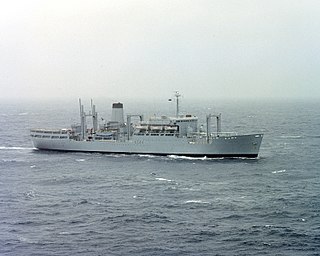
RFA Stromness (A344) was a fleet stores ship which served the Royal Fleet Auxiliary until sold to the U.S. Navy's Military Sealift Command in 1983. While in the service of British forces, it saw service in the Falklands War. After the sale to the United States, it was renamed USNS Saturn (T-AFS-10) and acted as a combat stores ship until it was deactivated in 2009; it was able to supply two other ships at once. In 2010, it was sunk in an exercise by the U.S. Carrier Strike Group Two off the coast of North Carolina.

Military Sealift Command (MSC) is an organization that controls the replenishment and military transport ships of the United States Navy. Military Sealift Command has the responsibility for providing sealift and ocean transportation for all US military services as well as for other government agencies. It first came into existence on 9 July 1949 when the Military Sea Transportation Service (MSTS) became solely responsible for the Department of Defense's ocean transport needs. The MSTS was renamed the Military Sealift Command in 1970.

Combat stores ships, or storeships, are ships used to store navel supplies. They are used to deliver supplies such as provisions and fuel to combat ships on extended deployments. The United States Navy operates the Sirius and Mars classes and the Royal Navy operates the Fort Rosalie and Fort Victoria classes. Storeships should not be confused with fast combat support ships which are high speed auxiliary ships or tenders which provide maintenance support to flotillas.
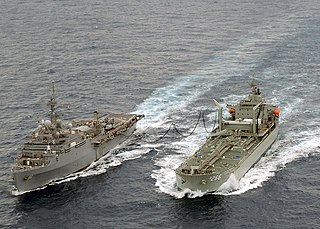
A replenishment oiler or replenishment tanker is a naval auxiliary ship with fuel tanks and dry cargo holds which can supply both fuel and dry stores during underway replenishment (UNREP) at sea. Many countries have used replenishment oilers.
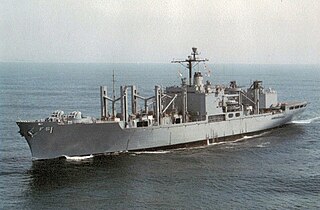
USS Mars (AFS‑1), the third United States Navy ship to bear the name, was laid down by the National Steel and Shipbuilding Company in San Diego, California, on 5 May 1962; launched on 15 June 1963, sponsored by Mrs. Clyde Doyle, widow of Representative Clyde Doyle of California; and commissioned at Long Beach Naval Shipyard on 21 December 1963.

USS Niagara Falls (AFS–3), a Mars-class combat stores ship, was the only ship of the United States Navy to be named after the City of Niagara Falls, New York. Commissioned into the US Navy on 29 April 1967, she served until September 1994, when she was transferred to the US Military Sealift Command to serve as USNS Niagara Falls (T-AFS-3). Assigned to the Naval Fleet Auxiliary Force, Far East, she served until 30 September 2008, when she was finally deactivated.

USNS Sirius was a Sirius-class combat stores ship of the United States Navy, named for Sirius (α Canis Majoris), the brightest star visible from Earth other than the Sun.

USNS Observation Island (T-AGM-23) was built as the Mariner-class merchant ship Empire State Mariner for the United States Maritime Commission, launched 15 August 1953, and operated by United States Lines upon delivery on 24 February 1954, making voyages for the Military Sea Transportation Service (MSTS) until going into reserve at Mobile, Alabama on 9 November 1954.

USS Thor was a cable repair ship that supported Project Caesar, the unclassified name for installation of the Sound Surveillance System (SOSUS). Originally the Artemis-class attack cargo ship Vanadis (AKA-49) which was briefly in commission from 9 July 1945 to 27 March 1946, it was converted in 1955 after nine years in the reserve fleet.

USNS Mount Baker (T-AE-34) was the seventh of eight Kilauea-class ammunition ships. She served in the United States Navy from 1972 to 1996 and with the Military Sealift Command from 1996 to 2010. She was scrapped in 2012.

USS Concord (AFS-5), was a Mars-class combat stores ship, in service with the United States Navy from 1968 to 1992. Concord became the first of five ships of its class to be transferred to Military Sealift Command. The transfer was completed in October 1992 and she was redesignated USNS Concord (T-AFS-5). Concord was stricken in August 2009 and sunk as a target in 2012.

USS San Diego (AFS-6) was a Mars-class combat stores ship acquired by the U.S. Navy in 1968. She served the U.S. Atlantic Fleet until decommissioned in 1993. She then was redesignated as a United States Naval Ship, assigned to the Military Sealift Command, and served in a non-commissioned status with a mostly civilian crew as USNS San Diego (T-AFS-6) until 1997.
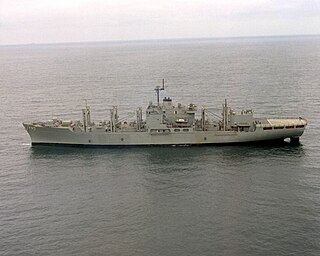
USS San Jose (AFS-7) was a Mars-class combat stores ship acquired by the U.S. Navy (USN) in 1970. She served as a Navy ship until November 1993, and was involved in the Vietnam War and the Persian Gulf War. The ship was transferred to the Military Sealift Command (MSC), and was redesignated USNS San Jose (T-AFS-7). As an MSC vessel, San Jose was involved in the INTERFET peacekeeping taskforce, the response to the December 2004 Indian Ocean tsunami, as well as the wars in Afghanistan and Iraq. The ship was deactivated in 2010, and was sold for scrap in 2013.
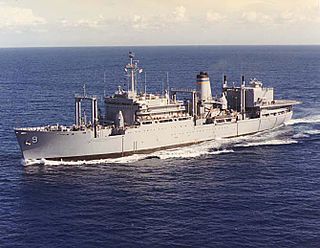
USNS Spica (T-AFS-9), was a combat stores ship acquired by the U.S. Navy from the United Kingdom in 1981. She participated in Operation Fiery Vigil to evacuate Clark Air Base personnel following the Mount Pinatubo Eruption in 1991. She served as part of the Military Sealift Command until she was deactivated in 2008.

USNS Sgt. Archer T. Gammon (T-AK-243) was a Boulder Victory-class cargo ship built at the end of World War II and served the war and its demilitarization as a commercial cargo vessel. From 1946 to 1950 she served the U.S. Army as a transport named USAT Sgt. Archer T. Gammon. In 1950 she was acquired by the United States Navy and assigned to the Military Sea Transportation Service. In 1973 she ended her career and was struck and scrapped.
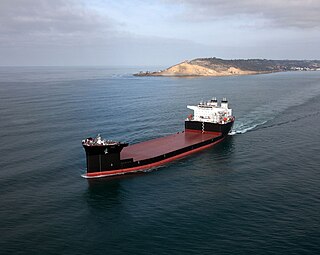
An Expeditionary Transfer Dock (ESD), formerly the Mobile Landing Platform (MLP), is designed to be a semi-submersible, flexible, modular platform providing the US Navy with the capability to perform large-scale logistics movements such as the transfer of vehicles and equipment from sea to shore. These ships significantly reduce the dependency on foreign ports and provide support in the absence of port availability. The class also houses a sub-class variant called the Expeditionary Mobile Base (ESB), formerly the Afloat Forward Staging Base (AFSB).
The Naval Fleet Auxiliary Force is a division of the US Navy. The 42 ships of the Military Sealift Command's Naval Fleet Auxiliary Force are the supply lines to U.S. Navy ships at sea. These ships provide virtually everything that Navy ships need, including fuel, food, ordnance, spare parts, mail and other supplies. NFAF ships enable the Navy fleet to remain at sea, on station and combat ready for extended periods of time. NFAF ships also conduct towing, rescue and salvage operations or serve as floating medical facilities. All NFAF ships are government owned and crewed by civil service mariners. Some of the ships also have a small contingent of Navy personnel aboard for operations support, supply coordination and helicopter operations.





















